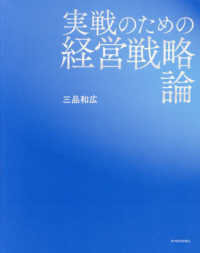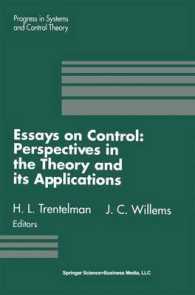- ホーム
- > 洋書
- > 英文書
- > Literary Criticism
Full Description
Employing a critical and analytical method, this volume takes an innovative approach to existing anthologies of medieval texts, proposing a comprehensive methodology for examining and understanding the historical and cultural construction of the image of women in medieval literature. Critically and analytically appreciating representative works and authors from the medieval period, Images of Women in Medieval Texts and Literature is interested not only in their essayistic examination but also in the intuitive perception of their values. This comprehensive approach fosters a deeper understanding of the image of women, particularly in the context of the Eve/Ave binomial, a dichotomy that shapes the defamation and defense of medieval femininity. The chapters present the misogynistic literary tradition as a comprehensive panorama, out of which emerged medieval literature praising women. Texts by the Fathers of the Church, from Tertullian (2nd century) to Saint Thomas Aquinas (13th century), are followed by those continuing their legacy, represented by Giovanni Boccaccio (14th century) and Geoffrey Chaucer (14th century). Finally, from this vast sea of defamation, toward the late Middle Ages, there emerged works, both anonymous and authorial, in praise of women, such as Dives and Pauper (15th century), The Thrush and the Nightingale (13th century), and the works of John Gower (14th century). Each of these works, in their own unique way, defends the women who were veiled and hidden away in the Middle Ages.
Contents
Introduction: Presence of Misogyny and its Legacy in Medieval Literature
Part 1: Misogyny in the Literature of the Ancient World and its Medieval Legacy
Chapter 1: Pronouncements of the Classical Science of Aristotle and Galen
Chapter 2: Influences of the Classical Literature of Ovid and Juvenal
Chapter 3: Pronouncements of Sacred Scripture
Part II: Misogyny in Medieval Literature
Chapter 4: Literature of the Fathers of the Church
Chapter 5: The Religious and Secular Literary Legacy of the Patristics
Chapter 6: Literary Vernacular Contributions in the Later Middle Ages
Part III: Praise of Women in the Literature of the Middle Ages
Chapter 7: The Anonymous The Thrush and the Nightingale
Chapter 8: Marbod of Rennes
Chapter 9 Abelard
Chapter 10: Albertano of Brescia
Chapter 11: The Anonymous Response to Le Bestiaire d'Amour by Richard de Fournival
Chapter 12: The Anonymous The Southern Passion
Chapter 13: John Gower
Chapter 14: Treatise in Refutation of Walter Brut
Chapter 15: The Anonymous Dives and Pauper
Chapter 16: The Anonymous A demanda do Santo Graal
Part IV: Women in the Bible: Between Defamation and Praise
Chapter 17: Discredited Women
Chapter 18: Admirable Women








